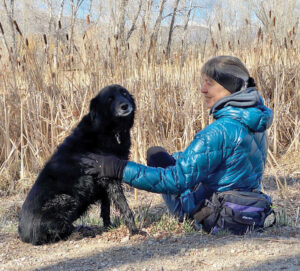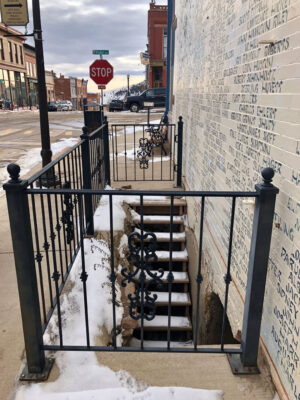By Ed Berg
Setting out on an early morning walk with Joe Dog, I passed two men on their way toward the F Street parking lot. They were obviously homeless. One was in bad shape, walking slowly with a stick and coughing hard enough that he had to pause to catch his breath. The other was pushing their belongings in a shopping cart. I said good morning, and he replied with a big smile, “Good morning! Another beautiful day!,” to which I responded, “It certainly is!” And we went on our economically and socially-distanced ways.
As we walked, I pondered the ways of our different worlds while Joe investigated trailside smells. I wondered what my responsibility to those two guys might be, and Joe didn’t. He lives in a state of satori, entirely present in every moment. On our way back toward town, a Claret Cup cactus caught my attention, just starting to bloom by the trailside. Here it was, in the midst of a severe drought, looking like it was going to its first prom. My first thought was that plants are optimists, spending all their energy on finery when their future is uncertain. The second thought was tempered by old scientific habits, knowing that seed production is a flowering plant’s best bet for propagating its species. To do that, it must attract a pollinator; thus the flashy advertisements. The cactus was responding to a survival challenge in a form that is attractive, in harmony with the present situation and rooted in the future. The beauty and the optimism were in the eye of this beholder, but were no less real than the thorns and flowers.
So here we are, living more or less socially distanced in our desert valley during our own survival challenge, with herds of cattle grazing in fields growing green with snowmelt irrigation and the streets of town growing crowded with herds of tourists bringing us their greenbacks from the cities. Things seem to be getting back to normal, whatever normal was, and some of us are wondering if that’s a good thing.
“Normal” describes a situation that has existed long enough that it escapes our notice. It doesn’t mean the situation is healthy. “Normal” in the Upper Arkansas Valley includes pleasant restaurants and pubs serving food and drink prepared here … but not made from ingredients grown here. It includes pastoral scenes of grazing cattle being raised by ranchers who struggle to find markets for their beef while the shelves in the meat sections of our supermarkets are half empty. It includes miles of prepared recreational trails and homeless men pushing shopping carts. It includes folks driving their cars wearing masks with the windows rolled up and grocery shoppers wearing no masks bending over produce displays. Fortunately, here in our valley “normal” doesn’t include police brutality and angry crowds looting stores. Life here includes a lot of contrasts, connections and disconnections.
We enjoy enough connections that we won’t loot a store that may belong to one of our neighbors. We suffer from enough disconnections that we choose to eat foods grown in countries that have poor medical systems and are experiencing huge outbreaks of COVID. The more I learn about our industrial food supply practices, the happier I am to spend more to buy food grown on a farm I can visit.
How do we heal the disconnections? Some of us work to enhance connections, volunteering to build mountain trails, creating local businesses or growing healthy food. Some of us enhance the disconnections, and speaking from personal experience, it is often the same person doing both, choosing between offering assistance instead of judgement, seeing an opportunity versus a threat or giving a neighborly “Good morning!” versus insisting on my personal freedoms, shifting my personal paradigm from wanting more to having enough, even if it can all fit in a shopping cart.
The scientific paradigms of reality are shifting away from understanding it as being made of separate objects, to seeing it as being holographic. A hologram is an image that contains the whole of the object. No matter how small you divide the image, it still portrays the whole. Advancements in physics during the last fifteen years show that every part of the universe, right down to the subatomic level, is in instantaneous communication with the information contained in the rest of the universe. It’s called quantum entanglement, and it means that you and I and Joe Dog, Claret Cups and cops are in touch with each other at a deep level, just the opposite of the centuries-old paradigm that we are separated by species, education, distance, our bodies, our wealth, and our status.
At the same time, advances in epigenetics show that our thoughts and attitudes shape our physical condition: we aren’t tied to the DNA molecule we were born with. We can change who we are at the deepest level through those daily choices. And that, friends, opens broad vistas of opportunities to shape our individual lives, our town and our nation.
We will see more food shortages in the near future, more conflicts and more pandemics. It is an election year, so we will see wild accusations and wilder promises. We will also see new norms replace the old norms that support our western consumer culture, norms that include slave-level labor in mines, lettuce fields and meat-packing plants. They are the old norms of deforestation to supply our beef, coconut oil and avocados, and it includes the trillion-dollar expenditures necessary to improving the weaponry that guarantees our consumption.
Our little valley and the way we choose to live here is a hologram: our daily responses to the threats and opportunities not only mirror the global changes that are taking place, but actually shape them. Whether we live in a dream home or out of a shopping cart, we can see the new day as a good morning or a threat, and respond like those thorny, beautiful, trailside cactuses.?
Ed Berg is recovering from his retirement from the oil industry by becoming an agricultural activist. It pays to give back to the Earth.


